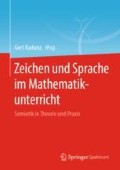Zusammenfassung
In diesem Beitrag wird eine Studie zur Erforschung von Lehrpraktiken des Translanguaging durch bilinguale Grundschullehrkräfte im Mathematikunterricht auf Malta vorgestellt. Zunächst werden theoretische Grundlagen zu Translanguaging und zur Mehrsprachigkeit im Mathematikunterricht dargestellt und theoretische Erkenntnisse in der kognitiven Mathematik in Zusammenhang mit dem Konstrukt Mehrsprachigkeit gebracht. Nach der Beschreibung der Methodologie und des Designs dieser Studie, die als Fallstudie charakterisiert werden kann, werden konkrete Beispiele vorgestellt, an denen sich die unterschiedlichen Funktionen zweier Sprachen beim Lehren und Lernen von mathematischen Inhalten in einem translingualen Kontext explizit herausarbeiten lassen. Während die Erstsprache im translingualen Mathematikunterricht in den analysierten Fällen auf Malta eher mündlich für die Darstellung konkreter Situationen und dynamischer Handlungen eingesetzt wird, tritt die Zweitsprache eher schriftlich auf, um abstraktere und statische mathematische Phänomene darzustellen.
Abstract
This chapter focuses on the study about research on teaching practices of translanguaging implemented by bilingual primary mathematics teachers in Malta. Theoretical background on translanguaging and multilingualism in mathematics classrooms is presented, followed by a synthesis of theories in cognitive mathematics to sustain their relationship to multilingualism and a description of the data methods and study design. As a qualitative case study, this study presents different empirical cases for researching the different functions two languages have when mathematical concepts are introduced at primary level in a translingual context. Results show that the first language tends to be used as an oral language for representing concrete situations and dynamic processes, whilst English tends to be used more in written form and to represent abstract and static mathematical phenomena in translingual mathematics classrooms in Malta.
Access this chapter
Tax calculation will be finalised at checkout
Purchases are for personal use only
Literatur
Baker C (2011) Foundations of bilingual education and bilingualism, 5. Aufl. Multilingual Matters, Bristol
Bauersfeld H (1983) Subjektive Erfahrungsbereiche als Grundlage einer Interaktionstheorie des Mathematiklernens und -lehrens. In: Bauersfeld H (Hrsg) Lernen und Lehren von Mathematik, vol 6. Untersuchungen zum Mathematikunterricht. Aulis Verlag Deubner, Köln, S 1–56
Bruner JS (1971) Toward a theory of instruction. Harvard University Press, Cambridge
Cummins J (1981) The role of primary language development in promoting educational success for language minority students. In: California State Department of Education (Hrsg) Schooling and language minority students. A theoretical framework. National Dissemination and Assessment Center, Los Angeles, S 3–49
Department of Curriculum Management Malta (Hrsg) (2014) Mathematics. A revised syllabus for primary schools
Jungwirth H (2003) Interpretative Forschung in der Mathematikdidaktik. Ein Überblick für Irrgäste, Teilzieher und Strandvögel. Zentralblatt Didakt Math 35(5):189–200
Lewis G, Jones B, Baker C (2012) Translanguaging origins and development from school to street and beyond. Int J Theor Pract 18(7):641–654
Maier H, Schweiger F (1999) Mathematik und Sprache. Öbv & Hpt, Wien
Mizzi A (2017) The relationship between language and spatial ability. An analysis of spatial language for reconstructing the solving of spatial tasks. Springer Spektrum, Wiesbaden
Moschkovich J (2005) Using two languages when learning mathematics. Educ Stud Math 64(2):121–144
Prediger S, Wessel L (2011) Darstellen – deuten – darstellungen vernetzen. Ein fach- und sprachintegrierter Förderansatz für mehrsprachige Lernende im Mathematikunterricht. In: Prediger S, Özdil E (Hrsg) Mathematiklernen unter Bedingungen der Mehrsprachigkeit. Stand und Perspektiven der Forschung und Entwicklung. Waxmann, Münster, S 163–184
Schwank I (2003) Einführung in funktionales und prädikatives Denken. Zentralblatt Didakt Math 35(3):70–78
Wessel L (2015) Fach- und sprachintegrierte Förderung durch Darstellungsvernetzung und Scaffolding. Ein Entwicklungsforschungsprojekt zum Anteilbegriff. Springer Spektrum, Heidelberg
Williams C (1996) Secondary education. Teaching in the bilingual situation. In: Williams C, Lewis G, Baker C (Hrsg) The language policy. Taking stock. CAI, Llangefni, S 39–78
Williams C (2002) Ennill iaith. Astudiaeth o sefyllfa drochi yn 11–16 oed [A language gained: A study of language immersion at 11–16 years of age]. School of Education, Bangor
Author information
Authors and Affiliations
Corresponding author
Editor information
Editors and Affiliations
Rights and permissions
Copyright information
© 2020 Springer-Verlag GmbH Deutschland, ein Teil von Springer Nature
About this chapter
Cite this chapter
Mizzi, A. (2020). Translanguaging im Mathematikunterricht. In: Kadunz, G. (eds) Zeichen und Sprache im Mathematikunterricht. Springer Spektrum, Berlin, Heidelberg. https://doi.org/10.1007/978-3-662-61194-4_7
Download citation
DOI: https://doi.org/10.1007/978-3-662-61194-4_7
Published:
Publisher Name: Springer Spektrum, Berlin, Heidelberg
Print ISBN: 978-3-662-61193-7
Online ISBN: 978-3-662-61194-4
eBook Packages: Life Science and Basic Disciplines (German Language)

